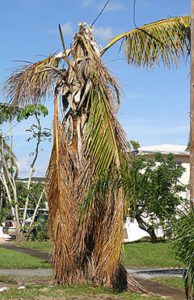A New Yorker cartoon shows a lady shopping a garden center bench for plants. She has three choices at three price points: annuals, $6; perennials, $10; eternals, $749.95.
No matter what the cost, plants don’t live forever. And if they did, what would they cost? They’d probably cost more than $749.95. Even though we know plants don’t live forever, we still don’t want a plant that we purchased, planted and cared for to die an early death.
All too often, I find myself in the position of reminding a person of this fact of life – plants don’t live forever.

Credit: Edward F. Gilman, UF/IFAS.
There are extremes, though. The bristlecone pine can live thousands of years. There is one that was named Methuselah, which, at one time, was believed to be the oldest living tree on record approaching more than 4,800 years of age in central California. But in the 1970’s, offspring of Methuselah all died because they were sent to low-altitude locations. The parent tree’s location in the White Mountains is two miles above sea level.
Even though the bristlecone pine can live thousands of years, misplacing it (planted at too low an altitude) results in the tree living a fraction of its potential life. The point is to plant the right plant in the right place. Make sure the plant is well suited for Florida and to the site conditions: that wet site, that dry site, that salty site, that high pH site, that shady site, that sunny site, etc.
The second point is to have realistic expectations based on the plant species. Some plants genetically will live longer than others. One of our longest-lived tree species in Florida is the live oak. There are live oak trees in Florida that are hundreds of years old. But don’t expect a silver maple to make it that long. It’s a shorter-lived tree species. In Florida, a thirty-year-old silver maple is probably in a state of decline due to old age.
The third point is to learn how to correctly plant and maintain the plants you have. For example, most woody plants (trees and shrubs), will live a much shorter life simply from being planted too deep. And an over fertilized centipedegrass lawn will go into a state of decline resulting in the lawn living a shorter life.
Plant the right plant in the right place, learn what it likes and provide it. And when the plant reaches the end of its life, replace it.
Many homeowners spend more than $749.95 attempting to turn a short-lived plant into an eternal plant.
 0
0
